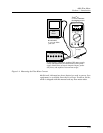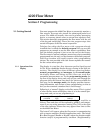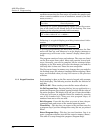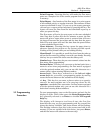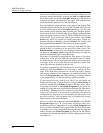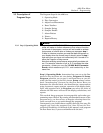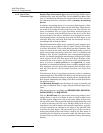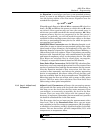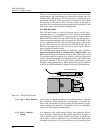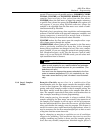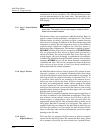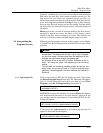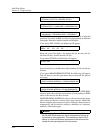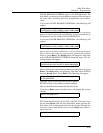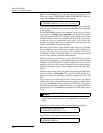
4220 Flow Meter
Section 2 Programming
2-7
An Equation is used when you have a non-standard primary
device, or want to use different values from those programmed
into the look-up tables of the flow meter. Equation uses the
standard flow equation:
Q = k1H
P1
+ k2H
P2
Where Q equals flow rate; k1 and k2 are constants; H is level (or
head), and P1 and P2 are the powers to which the two H terms
are raised. (Your equation may not have the second term, in
which case you would enter 0 for the second constant, k2.) Most
common primary devices are supported in the flow meter's
software, so generally you will not need this option. But it is
available for those needing to enter their own values, or for those
who have a nonstandard primary device for which an equation
can correlate level and flow.
MANNING Flow Conversion uses the Manning formula to cal-
culate flow in open or closed (non pressurized) gravity-flow situa-
tions based on slope, diameter, and roughness of the pipe. The
Manning formula is named for its developer, Robert Manning, a
19th-century Irish civil engineer. There is no primary measuring
device as such. Instead the pipe, with considerations for its slope
and internal roughness, serves as the primary device. The 4220
Flow Meter can calculate flow in round pipes, rectangular,
U-shaped, or trapezoidal channels based on this formula.
Data Point Flow Conversion (DATA POINTS) calculates flow
based on a set of user-entered data points for a flow stream. Data
consist of correlated level and flow measurements for the stream.
Like the Equation method of flow conversion, this flow con-
version is most commonly used where the primary measuring
device is nonstandard, but where tables of level and flow rate
data are available from the device manufacturer. The 4220 Flow
Meter has space for four sets of data with as many as fifty points
per set. The flow meter then calculates flow from these data
tables using a three-point interpolation.
2.3.3 Step 3 - Adjust Level,
Parameters
Adjust Level, Parameters calibrates the measuring sensors
that provide the flow meter with level and other information. In
this step you set the level that the flow meter measures. First
you measure, as accurately as possible, the level in the flow
stream. Then you enter this value with the numeric keys.
Accuracy is important. Remember that measured level provides
the basis for calculated flow in the flow meter.
The flow meter also has an input port for measurements other
than level. This is the Parameter Port. Here you can sense
such variables in the flow stream as temperature, pH (the acidity
or alkalinity of a solution) and D.O. (dissolved oxygen) in the flow
stream. You can have either pH with temperature, D.O. with
temperature, or temperature alone.
Note
The 270 D.O. module is no longer available from Teledyne
Isco.



